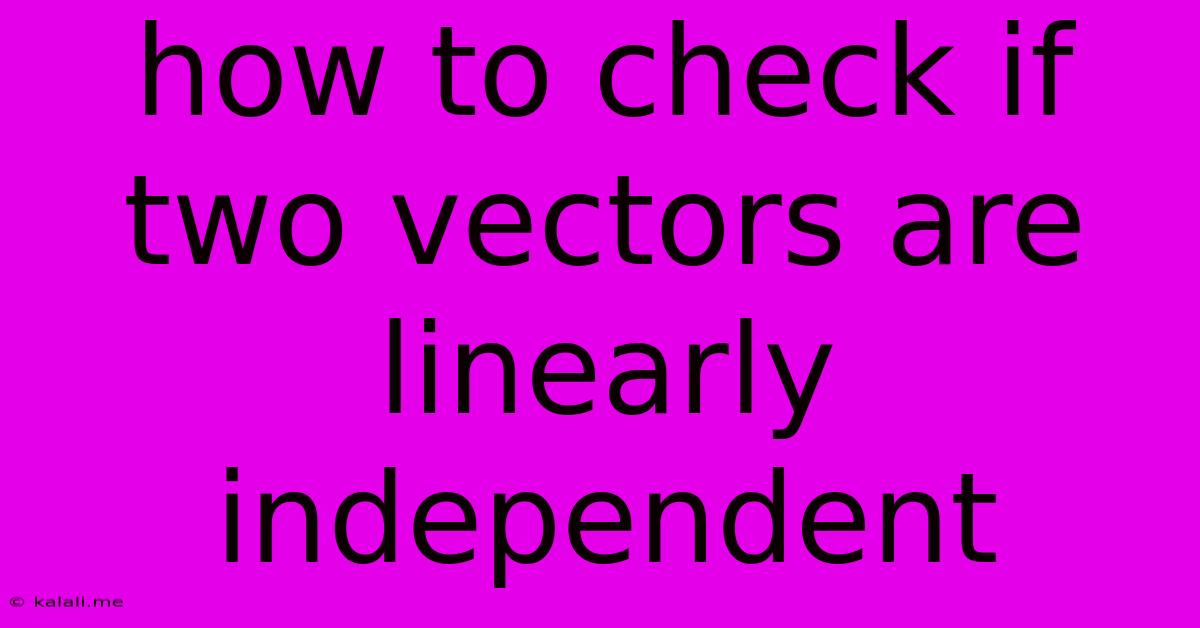How To Check If Two Vectors Are Linearly Independent
Kalali
Jun 02, 2025 · 3 min read

Table of Contents
How to Check if Two Vectors are Linearly Independent
Determining whether two vectors are linearly independent is a fundamental concept in linear algebra with applications across various fields, including machine learning, computer graphics, and physics. This article will explore multiple methods to efficiently check for linear independence, catering to different levels of mathematical understanding. Understanding linear independence is crucial for tasks like determining the basis of a vector space or solving systems of linear equations.
What does Linear Independence Mean?
Two vectors, let's call them u and v, are linearly independent if neither vector can be expressed as a scalar multiple of the other. In simpler terms, they don't point in the same or opposite directions. Mathematically, this means that the only solution to the equation au + bv = 0 (where 0 is the zero vector) is a = 0 and b = 0. If any other solution exists, the vectors are linearly dependent.
Methods to Check for Linear Independence:
Here are several methods to determine if two vectors are linearly independent:
1. Visual Inspection (for 2D vectors):
For two-dimensional vectors, a simple visual inspection can often suffice. If the vectors are plotted on a graph, they are linearly independent if they are not collinear (i.e., they do not lie on the same line). This method is intuitive but limited to low-dimensional spaces.
2. Calculating the Determinant (for 2D and 3D vectors):
This is a powerful method that extends beyond visual inspection.
-
For 2D vectors: Arrange the vectors as columns in a 2x2 matrix. If the determinant of this matrix is non-zero, the vectors are linearly independent. For example, if u = (u1, u2) and v = (v1, v2), the determinant is (u1 * v2) - (u2 * v1).
-
For 3D vectors: Similar to the 2D case, but using a 3x3 matrix. A non-zero determinant implies linear independence. Calculating the determinant for higher-dimensional vectors becomes computationally more expensive.
3. Row Reduction (for vectors of any dimension):
This is a more general method applicable to vectors of any dimension. Represent the vectors as rows (or columns) of a matrix and perform Gaussian elimination (row reduction) to obtain the row echelon form. If the resulting matrix has a pivot in every row (or column, depending on how you arranged the vectors), the vectors are linearly independent. This method is robust and computationally efficient, even for high-dimensional vectors.
4. Checking for Scalar Multiples:**
The most straightforward approach, though potentially less efficient for higher dimensions, is to directly check if one vector is a scalar multiple of the other. If u = kv for some scalar k (or v = ku), then the vectors are linearly dependent.
Example:
Let's consider two 2D vectors: u = (2, 1) and v = (4, 2).
-
Visual Inspection: We can see that v = 2u, meaning they are collinear and therefore linearly dependent.
-
Determinant Method: The determinant of the matrix [[2, 4], [1, 2]] is (22) - (41) = 0. This confirms linear dependence.
-
Scalar Multiple Check: Directly, we observe that v = 2u, confirming linear dependence.
Conclusion:
Determining linear independence is vital in linear algebra and its applications. The choice of method depends on the dimension of the vectors and the available computational resources. While visual inspection is useful for 2D vectors, the determinant method and row reduction offer more general and robust approaches for higher dimensions. Understanding these methods equips you to tackle problems involving vector spaces and linear transformations effectively.
Latest Posts
Latest Posts
-
How To Claim Authorship On Arxiv
Jun 03, 2025
-
How To Make Project On Census And Sample Method
Jun 03, 2025
-
What Is The Difference Between Convection Bake And Bake
Jun 03, 2025
-
Do 85mm Lens Work Up Close
Jun 03, 2025
-
Silicone Caulk Bathroom Countertop Using Acetone And Caulk
Jun 03, 2025
Related Post
Thank you for visiting our website which covers about How To Check If Two Vectors Are Linearly Independent . We hope the information provided has been useful to you. Feel free to contact us if you have any questions or need further assistance. See you next time and don't miss to bookmark.